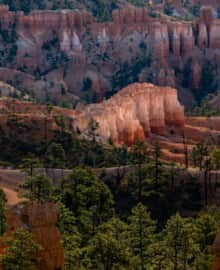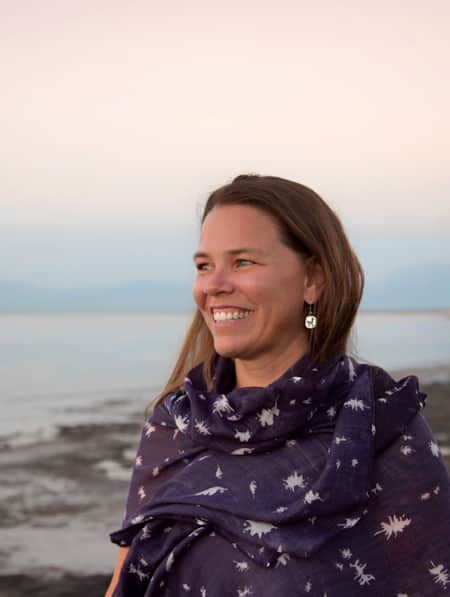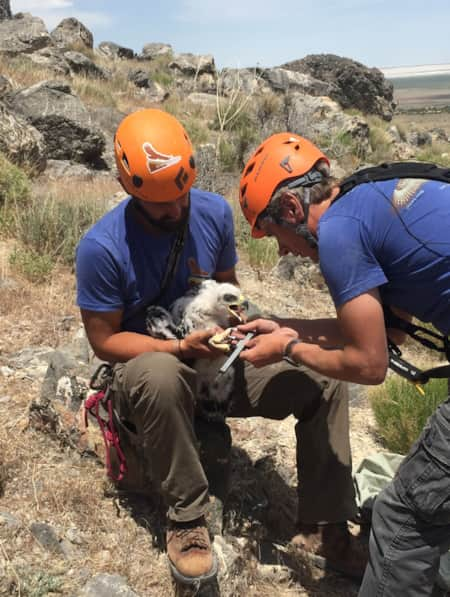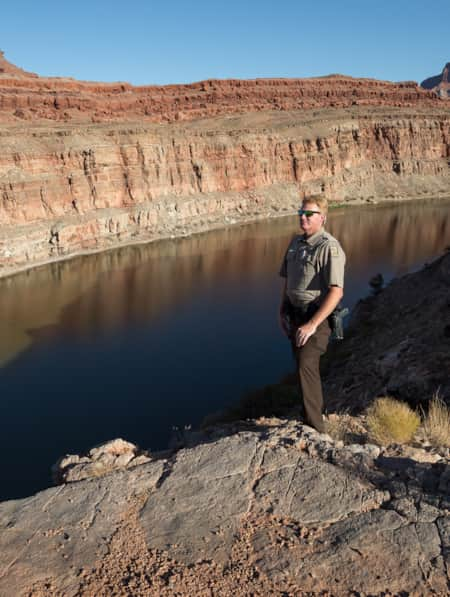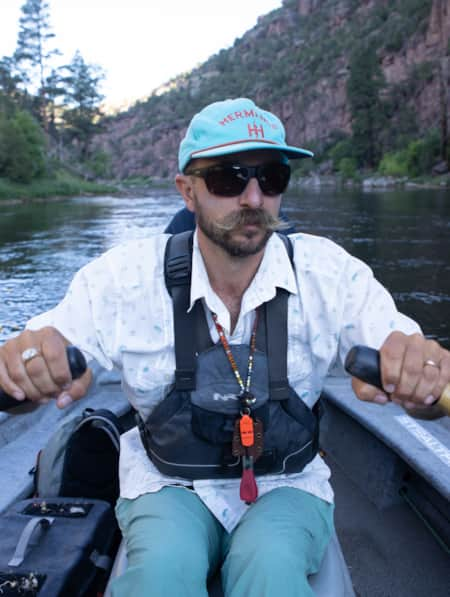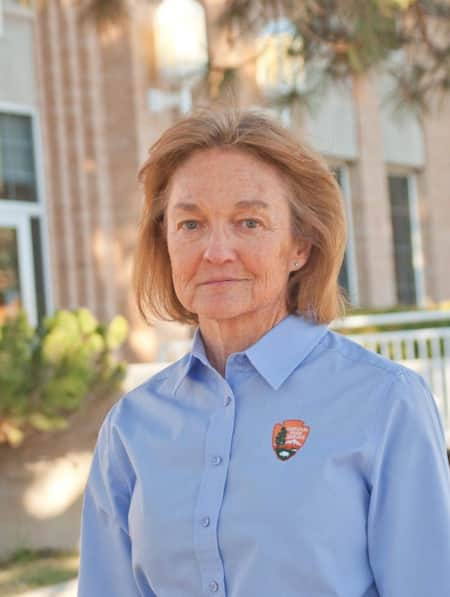Chapter 2: Confluence — Voices from San Juan County and Navajo Nation
Chapter 2, Part 8 | Gilmore Scott
Gilmore Scott grew up on the Navajo Nation doodling cartoon characters he saw on television. Teachers and peers encouraged him to pursue art as a career. Somewhere along the way he became a public lands forest firefighter and learned to look at the landscape he loves to portray in new ways.
"I definitely stayed away from the genre of what people called Native American or Indigenous art, where the colors are earth tones. The way people portray deserts is kind of bland. I think, boy you haven’t seen the colors out here in the desert. If you were here in the morning or the late evening the shadows and colors — the blues, the purples and the reds — just jump out at you. That’s what I really enjoy."
– Gilmore Scott, Artist in Montezuma Creek
Chapter 2, Part 7 | Steve Simpson
For Steve Simpson (owner of Twin Rocks Trading Post) growing up in Bluff, Utah, near Bears Ears National Monument meant exploring canyons to look for ancient ruins or cooling off in the San Juan River. After a lifetime of wandering the landscape around his childhood home, Simpson still wanders the land looking for, and easily finding, inspiration and wonder.
"You have to get out into Bears Ears to truly understand it. The spectacular scenery and the amazing natural resources are world class. "
– Steve Simpson, Owner of Twin Rocks Trading Post and Café in Bluff
Chapter 2, Part 6 | Willie Grayeyes
Willie Grayeyes started herding sheep as a three-year-old while living on Navajo Mountain. He later rode a donkey for miles to get water for his family. He ended up spending 16 years on the Navajo Nation Council and now serves as chair of the San Juan County Board of Commissioners.
"We have spiritual, psychological, physical, and also social, environmental ties to [the land]."
– Willie Grayeyes, Chair of the San Juan County Board of Commissioners
Chapter 2, Part 5 | Heidi Redd
Ranching, particularly in the desert, is a tough life. And when the ranch she loved came under threat, Heidi Redd found a unique way to protect it. Now, long after she has left the ranch for the last time, the landscape east of Canyonlands National Park will be protected from development.
"We are all extractive industries, from tourism, to climbers, to cattle — we extract a lot from the landscape. And if we aren’t willing to put more back than we take, that is when trouble happens."
– Heidi Redd, Owner of the Dugout Ranch
Chapter 2, Part 4 | Dave Bastian
Dave Bastian traveled to Utah to visit family as a child and always felt a pull to come back. He moved to Utah as an adult to partake in the diversity of outdoor experiences available in the Beehive state. Today, he manages a youth corps program in the Four Corners area as part of a stewardship program.
"I moved to Utah in my 20s. I was blown away with what we had here in terms of access. The ability to go places that are truly public. I realized they were completely open and belonged to us. It was a huge thing. It felt like this whole new world had just opened up to me."
– Dave Bastian, Partnerships Director at Canyon Country Youth Corps
Chapter 2, Part 3 | Steve Young
Steve Young was part of the local volunteer search and rescue team by the age of 13. So it is no surprise he ended up helping people enjoy the outdoors as a guide before moving on to his current job as a National Park Service river ranger on perhaps the most famous whitewater river in the country.
"After so many years of seeing people on river trips I believe it takes people about three days to disconnect from everyday life. That third morning they show up in camp and their body language is all relaxed. You can tell they finally unhooked from work and the chaos of life. They start to notice things they didn’t notice before and that’s when the trip becomes a truly memorable experience."
– Steve Young, River Ranger at Canyonlands National Park
Chapter 2, Part 2 | Vaughn Hadenfeldt
Vaughn Hadenfeldt developed an interest in archaeology at an early age, so it was not a surprise when he started guiding people to some of the numerous ancient cultural sites in southeastern Utah. He also ended up leading research teams to thoroughly document the locations. Through the years he preached a soft impact on the fragile landscape to protect the precious places he was sharing."I have to admit each client was different. Some I didn’t feel as comfortable with so I might show them one thing and not another. I made the decision out there. I always felt more comfortable showing people rock art than a 1,000-year-old ceramic vessel."
– Vaughn Hadenfeldt, Retired owner of Far Out Expeditions in Bluff
Chapter 2, Part 1 | Nikki Cooley
Nikki Cooley spent her childhood wandering the southwest desert herding sheep, then took up guiding river trips and now leads efforts to help Native American tribes cope with, and help prevent, climate change.
The draw of the river was so strong, there were times Nikki did her college homework on the water while learning how to be a guide. Hear about her journey and commitment to hard work that built and sustains her powerful connection to the river and place.
"The moment I stepped on that raft — I can’t explain the feeling. I had always belonged there, and it was my first time on a raft or boat of any kind. I felt like that is where I needed to be at that point in my life."
– Nikki Cooley, Member of the Navajo Nation; Co-Manager of the Tribal Climate Change Program at the Institute for Tribal Environmental Professionals
Chapter 1: Grand View Point — Southeastern Utah
Chapter 1, Part 1 | Brody Young
While on patrol one fateful November night, Moab park ranger Brody Young was shot nine times and left for dead in Utah’s red rock desert. In our first episode of the Six Corners Podcast, Brody recounts his harrowing story of personal tragedy and how the landscape at the epicenter of it helped him heal. (Read: How the Life of One Utah State Park Ranger Reveals the Healing Power of Nature)
"I think we all have a reason to be here. We each have the same value, and it doesn't change no matter what you do in life. Good and bad choices, our value doesn't change."
– Brody Young, Utah State Park Ranger
Chapter 1, Part 2 | Kirstin Peterson
Moab’s slickrock and sand lures thousands of mountain bikers each year who come hungry for a taste of red on their tread, but unprecedented popularity in the past year has had a profound impact on the surrounding environment. Rim Mountain Bike Tours owner Kirstin Peterson walks us through the unique challenges Moab is facing today and what it needs to be protected tomorrow.
"As more and more people are enjoying this place, we really have to up our efforts to make sure that they're leaving it as they found it."
– Kirstin Peterson, Owner of Rim Mountain Bike Tours
Chapter 1, Part 3 | Kara Dohrenwend
Rain is uncommon in Utah’s dry southeastern corner, but delicate plant life can still be found blossoming across its fiery red soil. What makes this flora so special and what is being done to protect it? Kara Dohrenwend, owner of Rim to Rim Restoration, shares her insights from working to revegetate the Upper Colorado Plateau.
"Slow down and maybe listen to it a little bit...the desert can be an amazing introspective place if you give it the time...look for patterns. There's some interesting things to see out here if you stop long enough to really look."
– Kara Dohrenwend, Owner of Rim to Rim Restoration
Chapter 1, Part 4 | Joette Langianese
While many of us were just waking up this summer, Arches National Park was already closing — as early as 7 a.m. — due to overcrowding. It’s become the center of a national conversation: how do we protect the parks in an era of high visitation and viral social media posts that leave no natural wonder undiscovered? In this episode, we talk with Moab Mayor-elect and executive director of Friends of Arches and Canyonlands Parks, Joette Langianese, about the Arches problem.
"Particularly in the parks, they're seeing a lot more damage to resources just because people don't understand...we want them here, but we want to make sure they know how to respect and steward the land at the same time."
– Joette Langianese, Moab Mayor-elect and Executive Director of Friends of Arches and Canyonlands Parks
Chapter 1, Part 5 | Spencer Stokes
It’s home to the best view in Moab you’ve probably never heard of, but there’s more to Dead Horse Point than its stunning, big screen-worthy vistas of the Colorado River. Park ranger Spencer Stokes sits down with us to share some of his favorite ways to experience Dead Horse Point State Park at the rim and beyond.
"Do some research. Understand what level you are comfortable with. And always when you're out there hiking, keep the ten essentials with you, like food, water, headlamp always, no matter what time you're out."
– Spencer Stokes, Park Ranger at Dead Horse Point State Park
Chapter 1, Part 6 | Betsy Bryne
Mill Creek winds its way through a beautiful red rock canyon and right into the heart of Moab. Once a quiet local favorite, you can now expect to see thousands of visitors hiking, swimming and recreating in the area each year. In our final Six Corners episode of this series, we speak with Betsy Bryne, a landscape architect with the National Park Service, who is working to preserve and maintain accessibility to Moab’s Mill Creek.
"We have a beautiful state with lots of beautiful land to go and access, but it is also kind of a delicate landscape, and it can be damaged in ways that aren't repaired for decades or hundreds of years."
– Betsy Bryne, Landscape Architect with the National Park Service
Remember to PREP
When preparing for the interviews, producer Matt Linton landed on a simple shorthand to communicate the focus of the show. His acronym, PREP, captures four practices he discusses with some of the guests: Prepare, Respect, Enjoy and Preserve
Prepare: Take time to research and learn about where you are traveling to improve the experience and outcome for you, your host community and the landscapes you visit.
Respect: Take care of the locations you visit by traveling thoughtfully, including following the Seven Principles of Leave No Trace and encouraging others to do the same.
Enjoy: Be in the moment by taking time to appreciate your surroundings. When possible, remove yourself from outside distractions such as cell phones and social media.
Preserve: Leave the places you visit as good or better than you found it so all can enjoy them in the future. When possible, contribute by supporting local or giving back.
